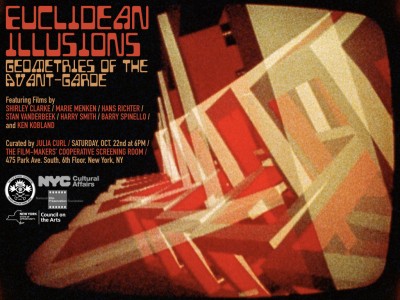Screening
Euclidean Illusions: Geometries of the Avant-Garde

This chronological selection of films from the Film-Makers’ Cooperative archive looks at the ways in which avant-garde filmmaking experimented with different methods of geometric abstraction from 1921 to 1980.
Beginning with Hans Richter’s very first film, Rhythmus 21, the medium was reimagined as a moving canvas onto which the filmmaker could paint their own world of forms, detached from a physical reality beyond the screen. Or, in the case of Marie Menken’s Visual Variations on Noguchi, Shirley Clarke’s Bridges-Go-Round, or Ken Kobland’s Library, the screen became a way to distill the geometric elements of real-life sculpture and architecture into a pure aesthetic experience outside of material function. This sampling closes with a look toward the creative possibilities of computer animation, realized during Stan VanDerBeek’s artistic residency at NASA in Houston.
Curated by Julia Curl. Happening at the Film-Makers' Cooperative Screening Room (475 Park Ave. South, 6th Floor, New York, NY) on SATURDAY, OCTOBER 22nd, at 6pm.
PROGRAM:
1. Hans Richter, Rhythmus 21 (1921, B&W, silent, 2.5 minutes)
2. Marie Menken, Visual Variations on Noguchi (1945, B&W, sound, 4 minutes)
3. Harry Smith, Early Abstractions (1946, color, sound, 23 minutes)
4. Shirley Clarke, Bridges-Go-Round (1958, color, sound, 7.5 minutes)
5. Barry Spinello, Six Loop-Paintings (1970, color, sound, 11 minutes)
6. Ken Kobland, Library (1977, color, optical sound, 3 minutes)
7. Stan VanDerBeek, Euclidean Illusions (1980, color, sound, 9 minutes)